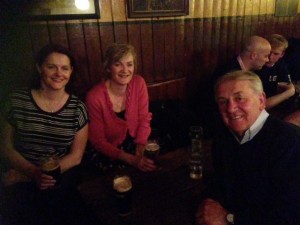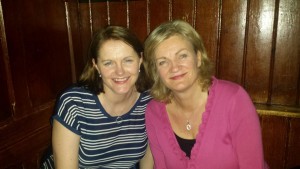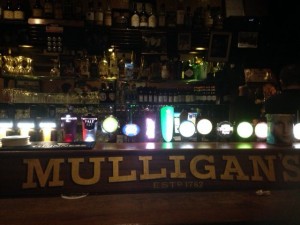

Gravediggers
The all-Ireland pub crawl began with a rare visit to Dublin’s north side, when Grainne, Jill and myself headed over to Kavanaghs pub, otherwise known as ‘The Gravediggers’. Our plan is to visit each of the 15 pubs show cased in RTEs’ documentary ‘The Irish Pub’ by the end of 2016, and whilst we’re off to a slightly later start than planned, we are confident we can test the quality of the hospitality, the speed of the banter and the warmth of the welcome in all 15 hostelries before Auld Lang Synne kicks in. We order the pints and settle at a table which has been worn to a rugged surface by decades of rough hands and creamy pints. Jill finds grooves in the wood which offer natural dips for her fingers, and we imagine the decades of thick working hands pressing on the table to emphasise their point; rubbing the grain to soothe the atmosphere, creating these hollows which now offer such a perfect resting place. We perch precariously on the skinny benches, made for bums a great deal smaller than our own and sip deeply, practically smacking our lips. 
We are joined by our colleague Tommy Cooke, who grew up three streets away in a two-up, two-down terraced house. Three generations of Tommy’s lived in the house he tells us: himself, his dad and grandfather, and he gives us a great insight into life around the cemetery and the nickname for the pub. Apparently, those employed to dig graves weren’t allowed to leave the adjoining cemetery grounds during their shift, so they’d bang on the side of the pub with their shovels, the number of bangs indicating the number of pints of black required. The owner would then hobble around the front of the pub to hand the pints through the railings, often accompanied by a plate of sandwiches. In the summer months, Tommy and his pals would play football outside the pub, watching for the gravediggers’ approach, and earn themselves a few pence by fetching the lunches and pints.
There’s a photo of Tommy in the pub. Taken in 1951, Tommy is a baby in his mothers’ arms when the family were snapped gathering outside Kavanaghs’ for the arrival of a bus to take them on a day out, organised by the publican. This was a regular event, and one which all the neighbours participated in. I remember those kinds of trips too from my London, second generation Irish childhood, but ours were organised through the church and generally involved a trip to the seaside, and an inevitable awkwardness as we witness the stripping of clothes on the beach, the dazzling white skin so rarely exposed and the strangely unsettling sight of the men’s’ skinny legs, usually firmly covered up.
The Gravediggers had no toilet for years, and the door leading to the yard is still there, albeit now blocked with a large metal bar. Modern amenities have replaced the necessity for a trip to the end of the yard, but back then on the relatively rare occasions that women drank in the pub, the door would be blocked by their male chaperone, ensuring they wouldn’t be interrupted by any eager or under pressure man rushing out to the convenience area.
In a wonderful synergy with the current times, Tommy tells us about his familys’ involvement in the uprising, and how his grand uncle, a volunteer, was killed on the barricades during the fighting in North King Street. Tommy attended the centenary events which were held exclusively for relatives of those killed. But, as with so many families, there are contradictions in Tommy’s history too, with his Grandfather heading to France in 1918 to fight for the British. At 38 years of age, he left his wife and children to fight in what many would have felt was somebody else’s war, but the decision was a purely economic one for a man whose trade was laying railway lines, a skill much needed to enable the transportation of supplies to the front.
Eventually it’s time to move on, and so reluctantly we give up our skinny benches, and Tommy’s wonderful reminiscences, and head for the second of our 15 named pubs in this all Ireland pub crawl. And for clarity, we didn’t decide on these 15, in fact we don’t agree that they all deserve be to be there and we can name several which should have been on the short list, but we are going with the 15 pubs featured in the RTE documentary ‘the Irish Pub’ for now. (We are open to a new list for 2017 though!)
We hop out of the car on the south side of the quays, thinking we look fabulous but vaguely aware of a hobble and a wobble, as the rapidly quaffed pints evidence themselves. it’s not far to the front door of Mulligans and we pause only for the required selfie before throwing open the creaking wooden doors. This is not a new venue for any of us, but judging by the crowds outside the pub, on the pavement and onto the street, it’s no longer one of Dublin’s ‘hidden gems’.
Moving through the dense crowd, we are disappointed to see that there is no space at our usual bar slot so we move through the back bar and around to the smaller space where we are able to stand at the bar and find somewhere to land our pints. It’s a great pub, with a tangible history, which even the freezing cold toilets can’t dispel. However, unlike the Gravediggers, which very obviously has a combination of locals as well as blow ins, it’s hard to identify anyone here who could offer a Tommy – like perspective. Maybe that’s due to the location? There aren’t many residential areas near here anymore but surely a pub this old has people who have been drinking here regularly over the decades because it’s their local. Tonight it’s full of tourists and office parties. No family connections, no decades old stories to share. Such a pity.








Leave a Reply